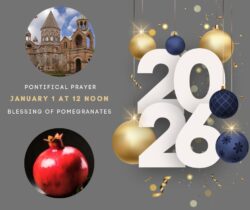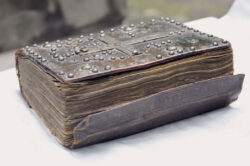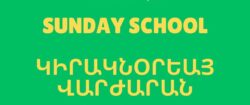Please contact church office or Father Hovhan directly to schedule Requiem (hokehankeesd) Service.
What are the different requiem services in the Armenian Church?
In the Armenian tradition there are different rituals after the funeral services and the internment of a Christian. These are held at various intervals. For convenience we shall refer to them as requiem services. The Book of Rituals [Mashdots] has special services for:
- the morning after the internment, when the ritual is held at the grave site; (For deceased clergymen, services are held at the grave site for six consecutive days.)
- the morning of the seventh day [yotnorek] of the internment, when the ritual is held at the grave site; (For deceased clergymen, services are also held on the 15
- the fortieth day [karasoonk] of the internment:
- for laymen the fortieth-day requiem is the same as the seventh day service
- for clergy there is a special fortieth-day service
- in the case of both deceased laymen and a clergymen the fortieth-day requiem is usually held on the closest (Saturday or) Sunday, when the name of the deceased is mentioned by the celebrant during the Divine Liturgy, particularly during the special prayers offered for the deceased;
- the first anniversary [dareleets] of the internment:
- for laymen the first anniversary requiem is the same as the seventh-day service
- for clergy there is a special first anniversary service
- the requiem is usually held on a (Saturday or) Sunday that is the closest to the date of the first anniversary, when the name of the deceased is mentioned by the celebrant priest during the Divine Liturgy, especially during the special prayers offered for the deceased;
- memorial days: the common requiem service [hokehankeesd], which follows the Divine Liturgy on five memorial days that follow the five major feasts during the year; the requiem for memorial days at the grave site can also be held on any day.
- In most modern Armenian cemeteries, the Divine Liturgy is celebrated in the cemetery chapels.
In the past, all the requiem services required the preparation of food and its distribution to the poor. This was the Armenian Christian way of providing for the deprived. This tradition has evolved today and is partially observed in the form of the hokejash.
The blessing of Madagh is in most cases a requiem service, and the blessed food or meat is distributed to the poor and the public at large in memory of the deceased person/persons, whose name is/are mentioned in the prayer read by the clergyman.
Blessed these, it must be noted that prayers for the deceased are said during the liturgical hours and the Divine Liturgy, and a short requiem service is required during the Night Hour, if the Divine Liturgy will be celebrated on that day.
These services, practices and traditions give us an opportunity to pray for our deceased dear ones and the receive consolation through the grace of the Holy Spirit.
What is the proper mourning period for a deceased?
Before examining the duration of the mourning period and the services following the internment, another question frequently raised by parishioners must be answered. Does one start calculating the time of mourning from the day when the deceased has died or from the day of his internment? This was never an issue in the old days, since the deceased was buried on the day he died. If the death occurred later in the day, the burial took place on the following day. Today, in countries where there is a wake prior to the burial, time should be calculated from the day of the burial services and the internment.
The forty-day mourning period
The forty days of mourning [karasoonk], says St. Gregory of Datev, has as precedent the wailing over Jacob/Israel. But his comment and our tradition are based neither on the Hebrew Scriptures nor on the present reading of the Septuagint, but on the ancient Armenian version of the Bible, which reads: and the embalmers embalmed [literally, covered] Israel. And his forty days were fulfilled; for so were the days numbered of those who were buried.
We see in the Old Testament, and know from various Armenian writers that besides wailing for the dead and other similar expressions of grief, the bereaved abstained from eating rich food, drinking and even bathing. The association of mourning with fasting and the example of Jacob presumably led to the present practice of observing a forty-day mourning period we observe today. The practice was probably further developed further developed under the influence of the forty-day Lenten period, during which the Church requires absolute abstinence from rich foods. The fortieth day of the internment marks the end of mourning, when the bereaved make a request for and participate in the celebration of the Divine Liturgy, then go to the gravesite for a requiem service. Today the requiem service is held in the church, with a shorter service at the gravesite.
First anniversary requiem
The significance of the first anniversary [dareleets] of the internment, and the annual observance of the burial is not clear, but the Book or Rituals does mention the dareleets and the tradition has been retained. At the first anniversary the family of the deceased makes a request for and participates in the celebration of the Divine Liturgy, and proceeds to the gravesite for a requiem service. Today the requiem service is held in the church, with a shorter service at the gravesite. The other anniversaries can be observed in the same manner. The annual observance is probably ancient, since it was faithfully implemented in the case of martyrs.
In the case of the karasoonk, the dareleets and the subsequent annual observances, the bereaved ask for celebration of the Divine Liturgy. This is important to know, since the Divine Liturgy is celebrated for both the living and for the members of the ‘victorious church.’ In Medieval times, people made substantial donations to monastic institutions and requested for the celebration of the Divine Liturgy on behalf of the souls of the souls of their beloved. The inscriptions on the walls of monasteries bear witness to this practice.
Why do we pray for the deceased?
The most basic teaching of our Lord Jesus Christ is: A new commandment I give to you, that you love one another: even as I have loved you, that you also love one another (John 13:34). This love is best expressed when we as loving brothers and sisters and as the true followers of the Lord come together to experience His presence in our midst: For where two or three are gathered in my name, there am I in the midst of them (Mat. 18:20). In such an atmosphere of binding love and Divine presence our prayers unite and come out as if from a single source. This is what the Lord had in mind when he taught us the Lord’s Prayer and stressed the use of the collective first person plural throughout.
Praying in one voice and as one person does not only indicate that we are all in agreement in our faith in God and in our expression of love towards each other, but also that we pray for each other. Prayer that is offered in unison will reach God: Again I say to you, if two of you agree on earth about anything they ask, it will be done for them by my Father in heaven (Mat. 18:19).
Praying together is strongly stressed by St. Paul, who in his letter to the Romans, 15:5-6, states: May the God of steadfastness and encouragement grant you to live in such harmony with one another, in accord with Christ Jesus, that together you may with one voice glorify the God and Father of our Lord Jesus Christ.
Common prayer is the very essence of the Church. And we must understanding that while offering private prayers should be a part of our daily practice, they do not take the place of common prayer, since, according to the Holy Scripture, we experience the presence of Christ in our midst as a group or a family, provided that we set aside our sinful ways and adhere to the divine command of love.
One may assume that all of this applies to those of us who are alive, since according to the general understanding, once a person passes away, he stops communicating with others and committing sin, and the sins committed during his lifetime are now a part of the record so to speak. The deceased will be judged at the great tribunal of the Last Judgment for the life they have led on earth. Consequently, why offer prayers for the deceased? Similar questions have been asked over the centuries and some Christians reject the practice of praying for the dead. The Armenian Church is obviously not one of those Christian groups.
Prayers for the dead, which are well attested from the Old Testament, and requiem services are based on an understanding derived from the Holy Scriptures and particularly from the New Testament. We believe that the faithful who are deceased are still the Lord’s: If we live to the Lord, and if we die, we die to the Lord; so then, whether we live or whether we die, we are the Lord’s. For to this end Christ died and lived again, that he might be Lord both of thedead and the living (Rom 14: 8-9).
The faithful who are dead are merely asleep in Christ. This concept, which is in St. Paul’s epistles (1 Cor 15; 1 Thes 4 and 5) is one of the basic teachings of the Armenian Church, and the term ‘asleep’ in its past participial form [nunchetsyal] is used formally in reference to a deceased person.
Like the faithful who are alive, the faithful who are deceased are a part of the corporate body of Christ and therefore of the Church. Those who are asleep in Christ and have reached the end of their earthly lives in the faith are referred to as the ‘first born’ or the Victorious Church.
The Scripture evidence also suggests that those who are asleep in Christ pray for themselves and for us. That the souls of the deceased are conscious and concerned about the living is best reflected in Christ’s story about poor Lazarus and the rich man. The latter begs the patriarch Abraham to send someone to his five brothers still alive to warn them of what is in store for sinners (Luke 16).
The indissoluble union of the living and the Victorious Church is also the basis for seeking the intercession of the saints before God. Asking a saint for his/her intercession merely means that we ask him/her to pray for us.
Father Hovhan is available to visit the cemetery following the Divine Liturgy and Memorial on the Sunday of the service per your request, where and when possible.















